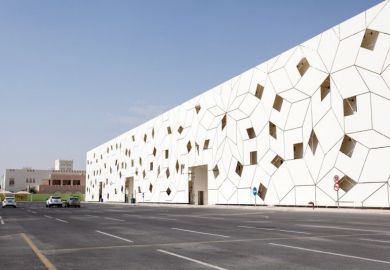More than $1 billion (£725 million) of investment in international branch campuses by the United Arab Emirates and Qatar is yet to repay itself in improved national research performance, a scholar has claimed.
New York, Northwestern and Carnegie Mellon universities are among the global institutions that have been attracted to set up outposts in the Gulf monarchies in recent decades.
Branch campuses were seen as a way of “fast-forwarding” diversification of the states’ economies and reduction of their reliance on oil and gas income, according to Christopher Davidson, a British expert in Middle East affairs. They also aligned with state initiatives to encourage citizens to work in the private sector, which is currently “heavily dominated by expatriates”, and to “quickly train up an indigenous cadre of new research professionals”.
On the side of Western partners, the lure was “very generous external funding”, Dr Davidson writes in a chapter of The Political Economy of Education in the Arab World, edited by Hicham Alaoui and Robert Springborg.
According to the US Department for Education’s Foreign Gifts and Contracts Report, NYU alone received 34 payments worth $80.7 million from Emirati government entities from 2012 to 2018, which does not include the cost of underwriting its Abu Dhabi campus in 2011.
From Qatar, Georgetown University received $350.9 million, Northwestern $340.2 million, Texas A&M University $274.7 million, Carnegie Mellon $266.2 million and Virginia Commonwealth University $40.7 million.
However, “the expected contributions of building a knowledge economy have not yet materialised”, Dr Davidson writes. “Only a very small number of actual citizens have been educated by these institutions, with an even smaller number having gone on to be employed in the UAE or Qatar.”
NYU Abu Dhabi’s class of 2022 is only 19 per cent Emirati. Meanwhile, Americans make up 45 per cent of the cohort, followed by students largely from Asia. Among those who graduated in 2018, less than half are now working in the UAE.
Georgetown University in Qatar’s class of 2022 is 32 per cent local citizens. The branches of Northwestern and Texas A&M fare better, with slightly more than half the student body being local.
Interviewees for the study, including 17 academics and administrators with links to five of the branch campuses, “expressed incredulity that such significant Emirati and Qatari state resources were essentially being lavished on foreign students”, writes Dr Davidson, an associate fellow of the Royal United Services Institute.
Scholars have also pointed to the “soft power” advantages of these campuses – not dissimilar to Gulf investment or collaboration with European football clubs or museums.
However, positive aspects may be offset by “negative international headlines” that have persisted since 2014, Dr Davidson writes. The universities have been criticised for everything from poor labour practices and academic freedom concerns to their treatment of LGBTQ speakers.
Looking forward, Dr Davidson predicts that the branch campus strategy could “face strong headwinds”, not only because of Western criticism, but also due to budget cutting in the Gulf.
He concludes that – despite some “undoubtably excellent” student experiences and research projects – there is the larger question of whether these campuses are actually expensive “bubbles” that do not address the larger development challenges of the region.
Register to continue
Why register?
- Registration is free and only takes a moment
- Once registered, you can read 3 articles a month
- Sign up for our newsletter
Subscribe
Or subscribe for unlimited access to:
- Unlimited access to news, views, insights & reviews
- Digital editions
- Digital access to THE’s university and college rankings analysis
Already registered or a current subscriber?







